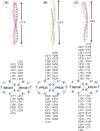Conformational flexibility of BECN1: Essential to its key role in autophagy and beyond
- PMID: 27414988
- PMCID: PMC5029530
- DOI: 10.1002/pro.2984
Conformational flexibility of BECN1: Essential to its key role in autophagy and beyond
Abstract
BECN1 (Beclin 1), a highly conserved eukaryotic protein, is a key regulator of autophagy, a cellular homeostasis pathway, and also participates in vacuolar protein sorting, endocytic trafficking, and apoptosis. BECN1 is important for embryonic development, the innate immune response, tumor suppression, and protection against neurodegenerative disorders, diabetes, and heart disease. BECN1 mediates autophagy as a core component of the class III phosphatidylinositol 3-kinase complexes. However, the exact mechanism by which it regulates the activity of these complexes, or mediates its other diverse functions is unclear. BECN1 interacts with several diverse protein partners, perhaps serving as a scaffold or interaction hub for autophagy. Based on extensive structural, biophysical and bioinformatics analyses, BECN1 consists of an intrinsically disordered region (IDR), which includes a BH3 homology domain (BH3D); a flexible helical domain (FHD); a coiled-coil domain (CCD); and a β-α-repeated autophagy-specific domain (BARAD). Each of these BECN1 domains mediates multiple diverse interactions that involve concomitant conformational changes. Thus, BECN1 conformational flexibility likely plays a key role in facilitating diverse protein interactions. Further, BECN1 conformation and interactions are also modulated by numerous post-translational modifications. A better structure-based understanding of the interplay between different BECN1 conformational and binding states, and the impact of post-translational modifications will be essential to elucidating the mechanism of its multiple biological roles.
Keywords: BECN1/Beclin 1/ATG6/VPS30; autophagy; class III phosphatidylinositol 3-kinase complexes; conformational flexibility; interaction hub; intrinsically disordered protein.
© 2016 The Protein Society.
Figures






Similar articles
-
Structural transitions in conserved, ordered Beclin 1 domains essential to regulating autophagy.J Biol Chem. 2017 Sep 29;292(39):16235-16248. doi: 10.1074/jbc.M117.804195. Epub 2017 Aug 10. J Biol Chem. 2017. PMID: 28798234 Free PMC article.
-
Conformational Flexibility Enables the Function of a BECN1 Region Essential for Starvation-Mediated Autophagy.Biochemistry. 2016 Apr 5;55(13):1945-58. doi: 10.1021/acs.biochem.5b01264. Epub 2016 Mar 21. Biochemistry. 2016. PMID: 26937551 Free PMC article.
-
Structural insights into BCL2 pro-survival protein interactions with the key autophagy regulator BECN1 following phosphorylation by STK4/MST1.Autophagy. 2019 May;15(5):785-795. doi: 10.1080/15548627.2018.1564557. Epub 2019 Jan 9. Autophagy. 2019. PMID: 30626284 Free PMC article.
-
Impaired autophagy and APP processing in Alzheimer's disease: The potential role of Beclin 1 interactome.Prog Neurobiol. 2013 Jul-Aug;106-107:33-54. doi: 10.1016/j.pneurobio.2013.06.002. Epub 2013 Jul 1. Prog Neurobiol. 2013. PMID: 23827971 Review.
-
The BECN1-USP19 axis plays a role in the crosstalk between autophagy and antiviral immune responses.Autophagy. 2016 Jul 2;12(7):1210-1. doi: 10.1080/15548627.2016.1173801. Epub 2016 Apr 20. Autophagy. 2016. PMID: 27096686 Free PMC article. Review.
Cited by
-
TRIM29 mediates lung squamous cell carcinoma cell metastasis by regulating autophagic degradation of E-cadherin.Aging (Albany NY). 2020 Jul 8;12(13):13488-13501. doi: 10.18632/aging.103451. Epub 2020 Jul 8. Aging (Albany NY). 2020. PMID: 32640423 Free PMC article.
-
Anticancer Effect of Dihydroartemisinin via Dual Control of ROS-induced Apoptosis and Protective Autophagy in Prostate Cancer 22Rv1 Cells.Curr Pharm Biotechnol. 2024;25(10):1321-1332. doi: 10.2174/1389201024666230821155243. Curr Pharm Biotechnol. 2024. PMID: 37605406
-
Regulation of the Tumor-Suppressor BECLIN 1 by Distinct Ubiquitination Cascades.Int J Mol Sci. 2017 Nov 27;18(12):2541. doi: 10.3390/ijms18122541. Int J Mol Sci. 2017. PMID: 29186924 Free PMC article. Review.
-
Epstein-Barr Virus Encoded BCL2, BHRF1, Downregulates Autophagy by Noncanonical Binding of BECN1.Biochemistry. 2023 Oct 17;62(20):2934-2951. doi: 10.1021/acs.biochem.3c00225. Epub 2023 Sep 30. Biochemistry. 2023. PMID: 37776275 Free PMC article.
-
The dynamic Atg13-free conformation of the Atg1 EAT domain is required for phagophore expansion.Mol Biol Cell. 2018 May 15;29(10):1228-1237. doi: 10.1091/mbc.E17-04-0258. Epub 2018 Mar 22. Mol Biol Cell. 2018. PMID: 29540529 Free PMC article.
References
-
- Liang XH, Jackson S, Seaman M, Brown K, Kempkes B, Hibshoosh H, Levine B (1999) Induction of autophagy and inhibition of tumorigenesis by Beclin 1. Nature 402:672–676. - PubMed
-
- De Duve C, Wattiaux R (1966) Functions of lysosomes. Annu Rev Physiol 28:435–492. - PubMed
-
- Lawrence BP, Brown WJ (1992) Autophagic vacuoles rapidly fuse with pre‐existing lysosomes in cultured hepatocytes. J Cell Sci 102:515–526. - PubMed
Publication types
MeSH terms
Substances
Grants and funding
LinkOut - more resources
Full Text Sources
Other Literature Sources

